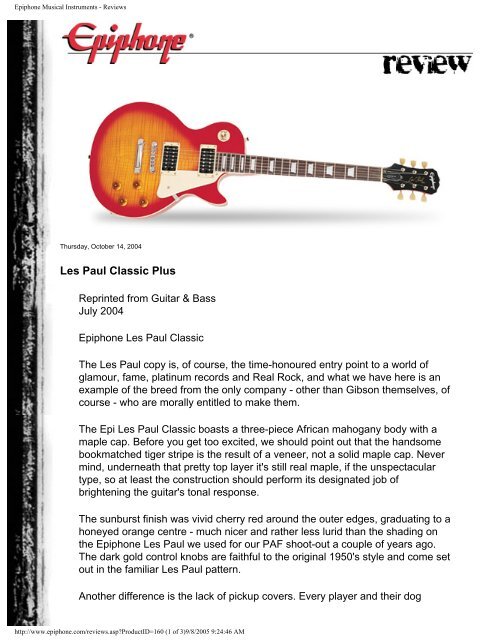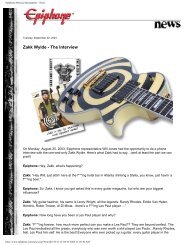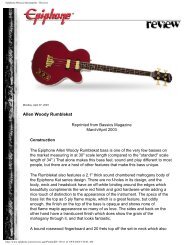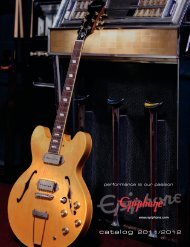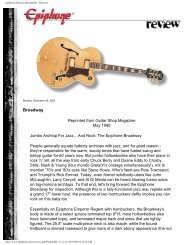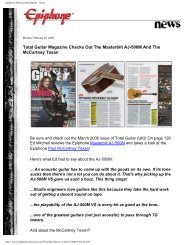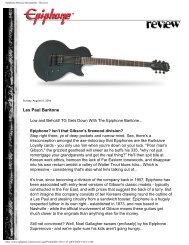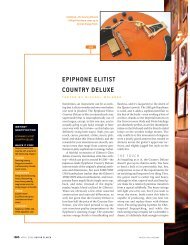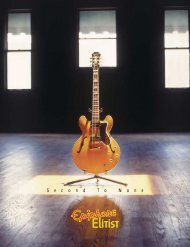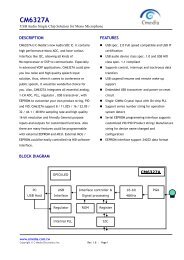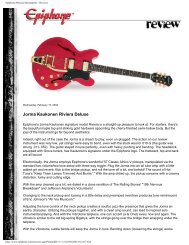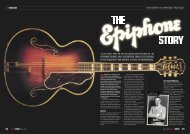Les Paul Classic Plus - Epiphone Musical Instruments
Les Paul Classic Plus - Epiphone Musical Instruments
Les Paul Classic Plus - Epiphone Musical Instruments
Create successful ePaper yourself
Turn your PDF publications into a flip-book with our unique Google optimized e-Paper software.
<strong>Epiphone</strong> <strong>Musical</strong> <strong>Instruments</strong> - ReviewsThursday, October 14, 2004<strong>Les</strong> <strong>Paul</strong> <strong>Classic</strong> <strong>Plus</strong>Reprinted from Guitar & BassJuly 2004<strong>Epiphone</strong> <strong>Les</strong> <strong>Paul</strong> <strong>Classic</strong>The <strong>Les</strong> <strong>Paul</strong> copy is, of course, the time-honoured entry point to a world ofglamour, fame, platinum records and Real Rock, and what we have here is anexample of the breed from the only company - other than Gibson themselves, ofcourse - who are morally entitled to make them.The Epi <strong>Les</strong> <strong>Paul</strong> <strong>Classic</strong> boasts a three-piece African mahogany body with amaple cap. Before you get too excited, we should point out that the handsomebookmatched tiger stripe is the result of a veneer, not a solid maple cap. Nevermind, underneath that pretty top layer it's still real maple, if the unspectaculartype, so at least the construction should perform its designated job ofbrightening the guitar's tonal response.The sunburst finish was vivid cherry red around the outer edges, graduating to ahoneyed orange centre - much nicer and rather less lurid than the shading onthe <strong>Epiphone</strong> <strong>Les</strong> <strong>Paul</strong> we used for our PAF shoot-out a couple of years ago.The dark gold control knobs are faithful to the original 1950's style and come setout in the familiar <strong>Les</strong> <strong>Paul</strong> pattern.Another difference is the lack of pickup covers. Every player and their doghttp://www.epiphone.com/reviews.asp?ProductID=160 (1 of 3)9/8/2005 9:24:46 AM
<strong>Epiphone</strong> <strong>Musical</strong> <strong>Instruments</strong> - Reviewsremoved the covers from their Gibson's in the 1960's and 1970's. The idea wasto get more output, but in reality all you could hope to achieve was slightly morehigh-end (this occurred because metal pickup covers have a capacitive effectthat rolls off the high frequency response - a bit like backing off your tonecontrols a little). Many early amps, such as some tweed Fenders and non topboostVox AC30s, could sound a little dark, so it's easy to see what promptedplayers to throw away the metal. Exposed pickups also look more rock'n'roll -like the top of an engine jutting through the bonnet of a 1950's hotrod. EarlyGibson humbuckers could have bobbins coloured cream, black or both; here,they're black.The pickguard, it has to be said, is dog rough. It's a bit of a mess at the pointyend, and the machining marks along the bottom edge are so lumpy, you can getsome impressive guiro-type effects - a guiro is oneof those riged SouthAmerican gourds that you scrape with a stick -by running your plectrum acrossthem. However, both thechrome-plated Tune-O-Matic bridge and tailpiece arequality items indeed,and this edition of the guitar has a set of genuine "kidney"Grover machineheads instead of the reproduction plastic-buttoned Klusons<strong>Epiphone</strong> used on previous models. The tuning is stable and solid, too, and theGrovers seem to be a real improvement over the Kluson copies.This <strong>Les</strong> <strong>Paul</strong>'s budget status is betrayed by the neck construction. The original,expensive way of doing it was to carve the neck from a single piece ofmahogany - a method that wastes significant amounts of rainforest, withdebatable sonic benefits. So the heel on this guitar is grafted on to the neck,and the headstock is fixed via a scarf joint that extends to the third fret. Theheadstock shape is traditional for <strong>Epiphone</strong>, but different to Gibson's originaldesign. It's painted black on its front and carries a gold 1950's-style "<strong>Les</strong> <strong>Paul</strong>"decal and a truss rod cover with a verticle "Gibson" brand along with the pearl"<strong>Epiphone</strong>" logo.The rosewood fingerboard carries plastic pearl "crown" markers and jumbofrets. The rosewood isnt top quality Brazilian of course - you wouldnt expect it tobe - but it's tidy enough and, like the body, it benefits from cream binding.Besides a couple of small runs and the odd fragment of stray red stain, thequality of the finish is very good. In fact it's rare to see a bad finish on Koreanguitars these days, so long as you don't expect hand-rubbed nitro-cellulose.Similarly, Korean fret-work is remarkably consistent - not as clinical as the bestEuropean and American manufacturers, but hard to fault.I genuinely admire the way that Gibson sticks to its Rhythm/Treble switchmarkings. It must be decades since players used neck pickups for everydayrhythm duties, and most blues players actually perform solos using the necksetting... but where would we be without our quaint traditions?I would describe this guitar as medium-weight, and the neck is skinny and fast.http://www.epiphone.com/reviews.asp?ProductID=160 (2 of 3)9/8/2005 9:24:46 AM
<strong>Epiphone</strong> <strong>Musical</strong> <strong>Instruments</strong> - ReviewsThe action is set fairly low with just the right amount of neck relief to avoid anunpleasant mechanical noises, and most players will feel at home fairly quickly.The acoustic sound is balanced, clear and sustains well.The stock pickups are serviceable enough, but nothing special. The bridge isvery throaty and dark on the low strings with more congestion in the mids than atop-quality replacement PAF, but the high frequencies do sound clean anddetailed. The neck pickup sounds much better, with a lovely, rounded qualityand a pure bluesy tonality - but, once again, the best replacement pickups willoffer better dynamic response and more overall smoothness.VERDICT: Meet the new boss, same as the old boss? Not quite. This is a verygood entry-level <strong>Les</strong> <strong>Paul</strong> built with the correct materials and finished to a highstandard. I personally like the re-style, and the overall vibe is that of a modifiedclassic with the pickup cover removal and tuner swapping already done for you.You wouldnt expect the worlds finest pickups on a Korean guitar - after all, theAmericans do have to keep something back to justify their prices. As Imentioned before, our PAF pickup shootout gave us the opportunity to becomefamiliar with this guitar and we can confidently report that these <strong>Epiphone</strong> <strong>Les</strong><strong>Paul</strong>s are capable of producing jaw-dropping good tones with a really good setof pickups. All you need to buy in the meantime is a decent case.Guitar & BassJuly 2004http://www.epiphone.com/reviews.asp?ProductID=160 (3 of 3)9/8/2005 9:24:46 AM


